How APU and CBU Research has helped shape the world outside the laboratory
The Armed Services
The APU was set up to assist the War effort. Although founded in 1944, the MRC and armed services funded the work initially in the Psychological Laboratory in the University. Among other topics work during that period had very real effects on:
Flying Hours & the Cambridge Cockpit

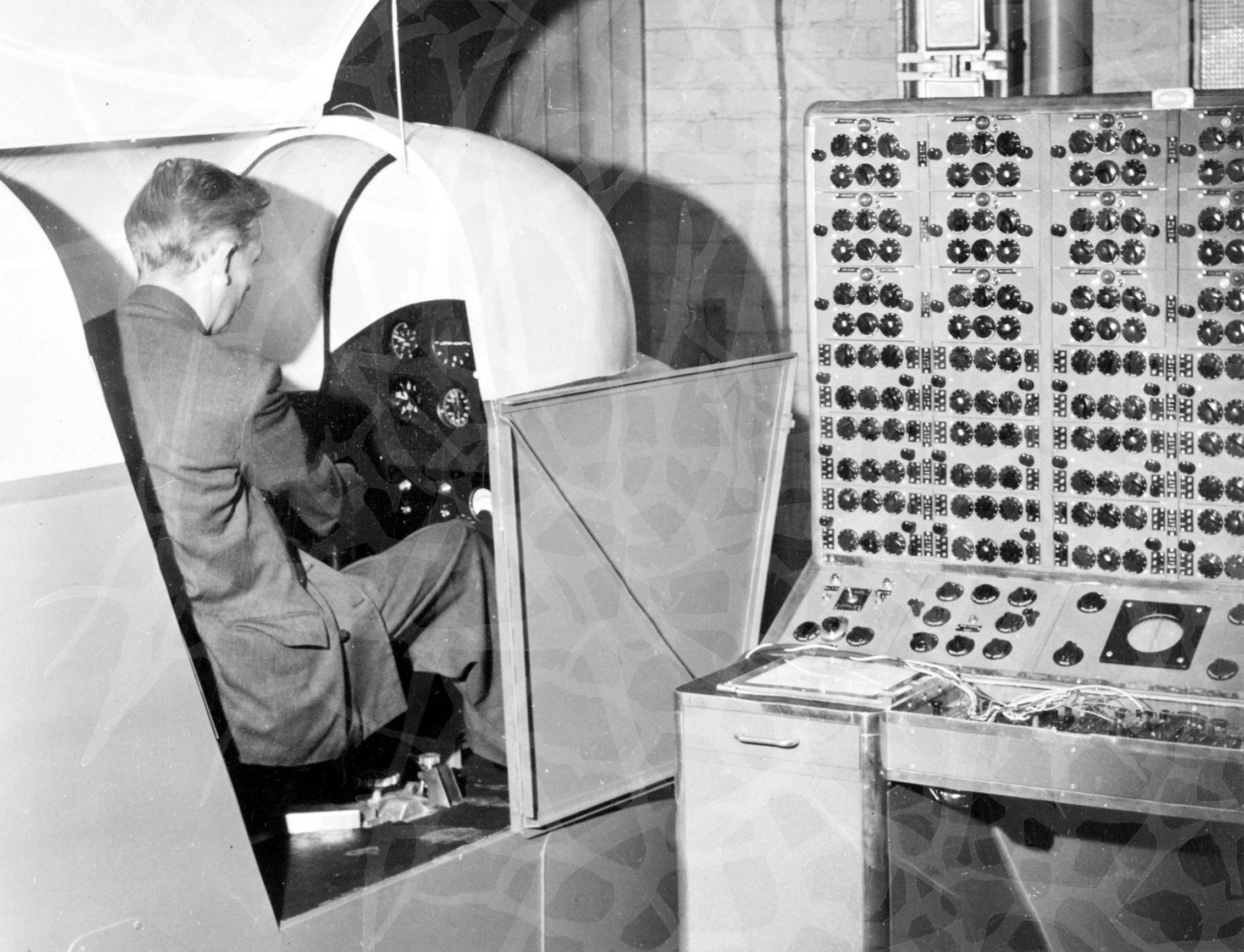
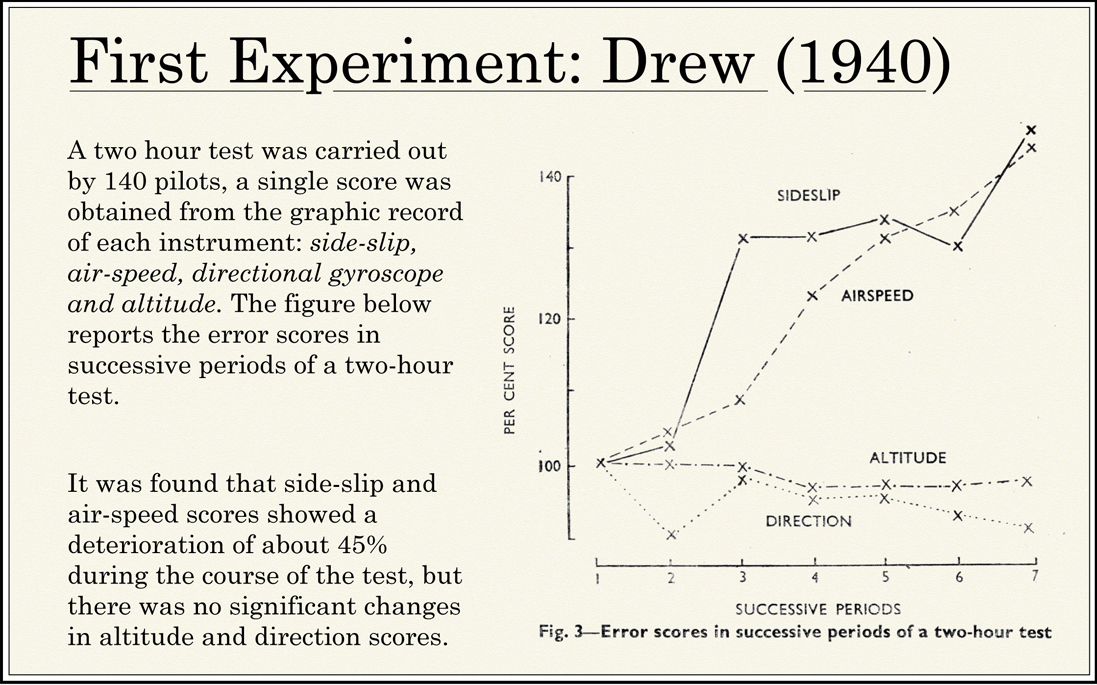
Flying Hours & the Cambridge Cockpit
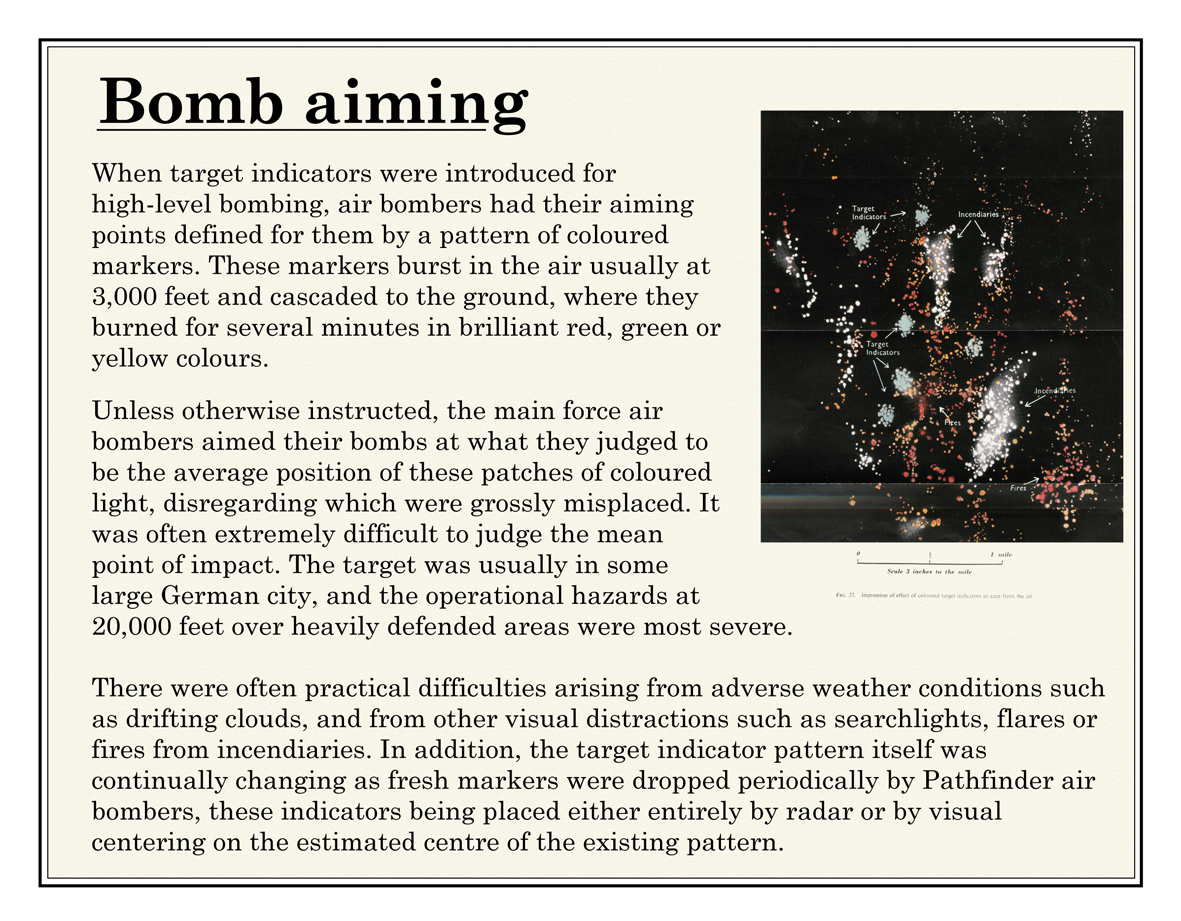

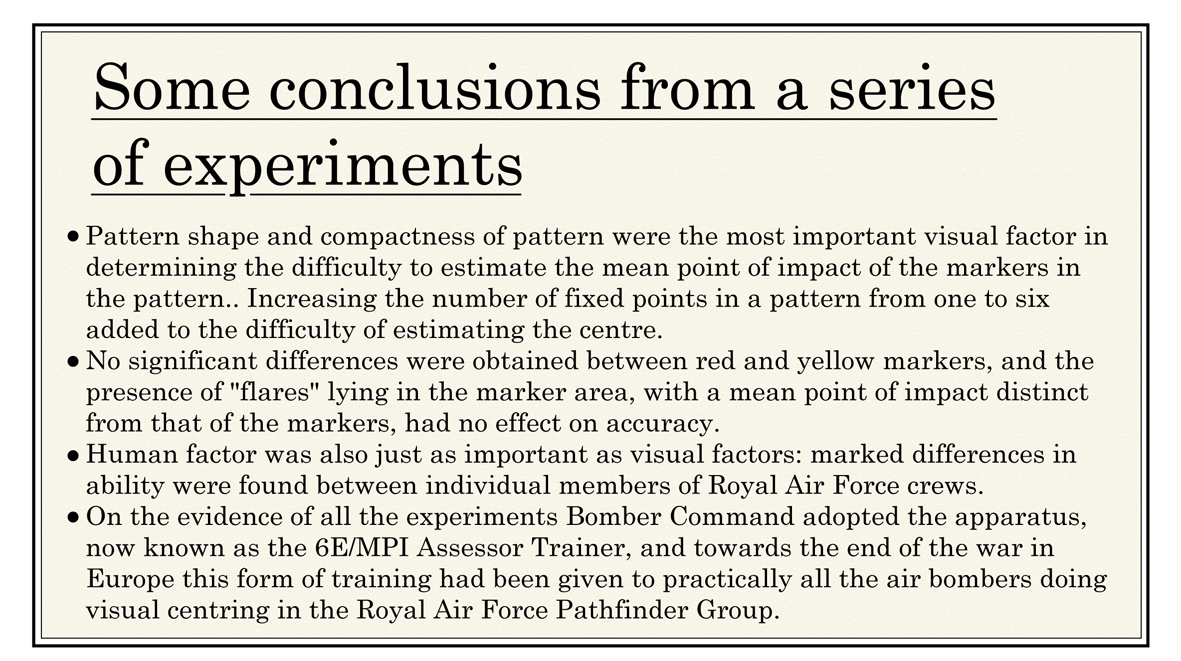
Wartime Experiments on the use of Sonar
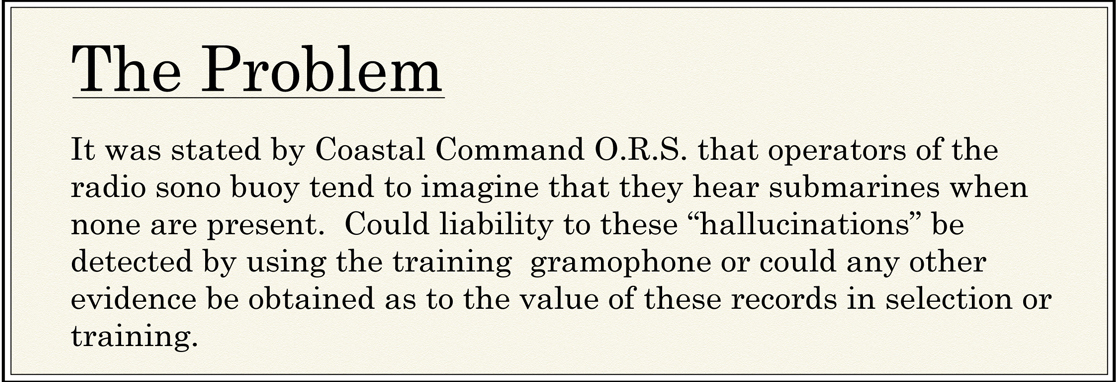
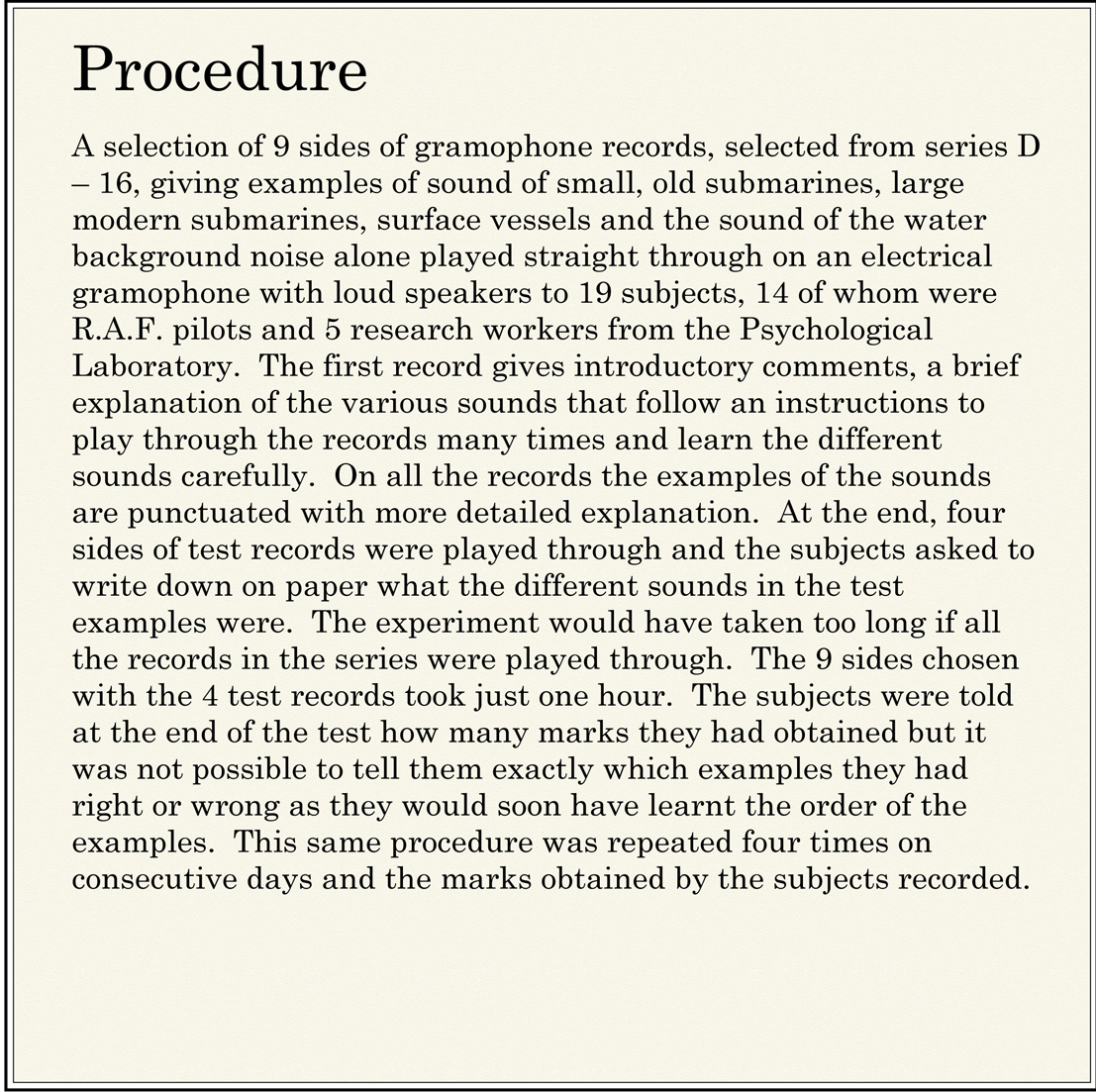


Fighter Command Control Rooms
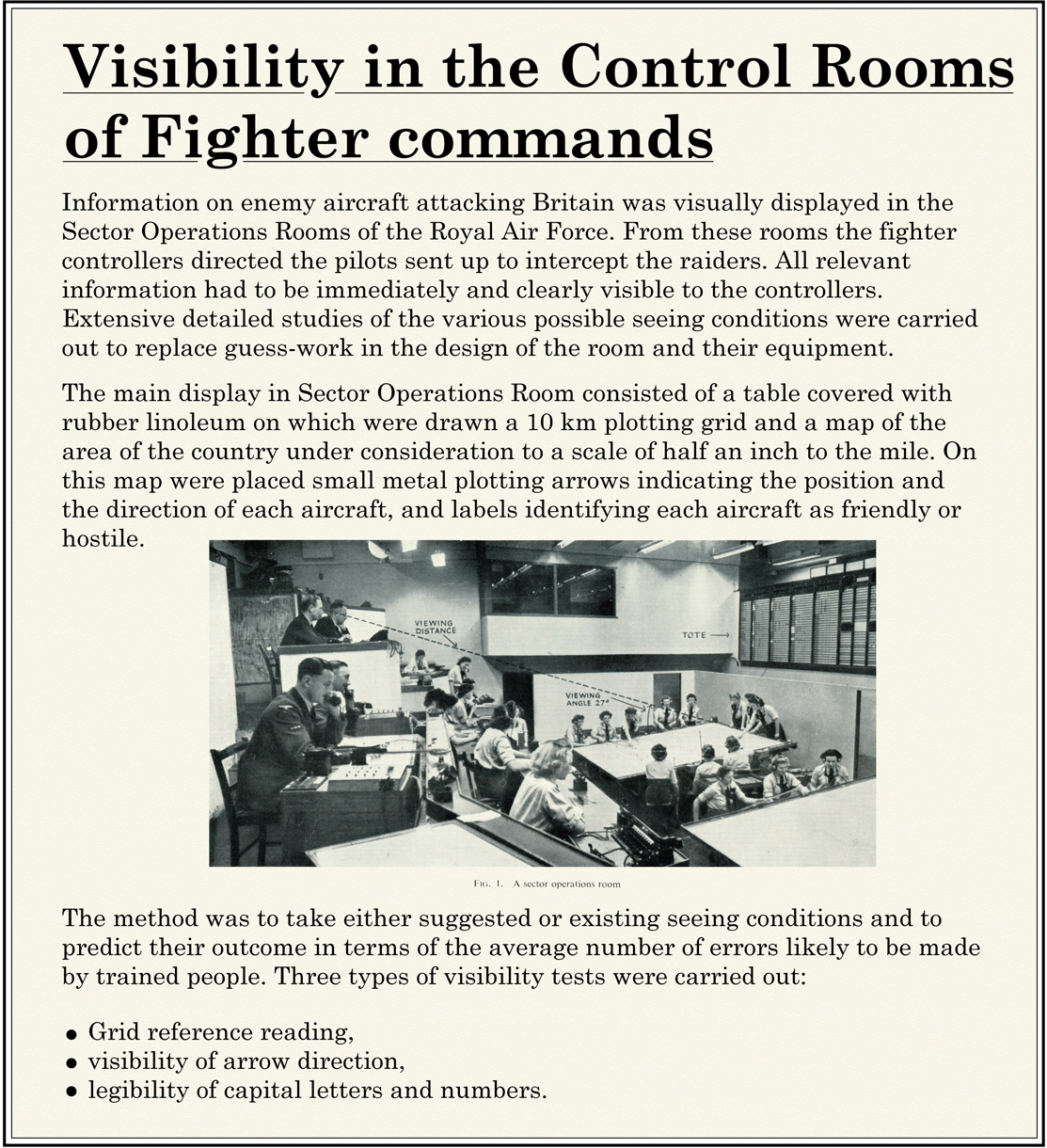


Although taking a reduced proportion of research effort, work continued up until the 1980’s. Examples
Research on heat
In the postwar era facilities at Chaucer Road included special purpose facilities for studying how people reacted when asked to perform tasks in noisy and hot environments.
The picture below shows military personnel carrying out tasks in a hot room.

Example studies from the 1940’s and 1970’s:
Effects of heat and high humidity on pursuitmeter scores (Mackworth, 1945)
The effects of heat on wireless telegraphy operators hearing and recording morse messages (Mackworth, 1946)
The interaction of the loss of a nights sleep with mild heat: Task variables (Poulton, Edwards & Colqhoun, 1974)
Performance after heat – disturbed sleep (Herbert, 1975)
Our Hot Room was dismantled in the 1970’s.
Research on heat
Research on the effects of noisy backgrounds were a prominent focus of research at APU throughout the 1950’s, 60’s and 70’s.
The detrimental effects of noise were studied on human performance in a wide range of practical and intellectual tasks, such as attention, vigilance, memory and language comprehension. Specific effects of noisy backgrounds on the speech perception were a particular interest. The emotional side-effects of noise were not ignored. One study in the early 1960’s examined subjective measurements of relative annoyance of simulated sonic bangs and aircraft noises.
Major reports on the effects of noise in the home environment were also prepared for the Buildings Research Establishment and for the Commission of the European Community.
As indicated by this quote from one of our former directors reflects APU’s core approach of synergies between theory and application:
‘The effects of noise seem to the writer to be of importance for any theoretical account of the working of the nervous system. Equally they are of practical importance, and their study gives a promising opportunity for the interplay of theoretical and applied research. Neither sound theories nor valuable facts, however, can be obtained without careful weighing of the evidence. Donald Broadbent, August 1955, Writing in The Royal Society of Health Journal on “Noise: Its effects on Behaviour”.
-
Aiming (now missiles)
-
Vigilance & attention, (e.g. multichannel communications)
-
Computerisation of military tasks
Industry, the Post Office, transport systems and government
In the post-war era, an increasing proportion of Unit effort was devoted to non-military applications. Typically, research problems were referred to the Unit by Government or Industry. Advice would be given, either from general scientific principles and data, or through the collection of new data. Practical problems and the research they gave rise to often led to significant extensions to psychological theory and basic neuroscience.
Examples topics are listed below – clicking on those highlighted items will take you to a new page. Those items marked with a {fc} contain a brief film clip made at the time the research was carried out and will give you an impression of laboratory practice in the 1950’s, 60’s and 70’s.
Mill work, inspection tasks, circuit testing and X-rays
n immediate post-war era, scientists attention gradually moved away from military applications and more on to the kinds of equipment and conditions of work in industrial and medical work settings. Although we could include many examples, here we illustrate three industrial tasks that inspired the interests of our scientists: Work in mills, Monitoring and quality control, Circuit testing and taking decisions about X-ray images. Each of these tasks raised important issues about how attention, memory, decision making and action are sustained in the contexts of repetitive and non-repetitive jobs.
The two pictures below show the working environment in a mill and the laboratory apparatus designed by Conrad to measure people’s ability to monitor many moving parts at once.

Other tasks of this sort included having to monitor whether or not there was something wrong with a product coming off a production line, checking electronic circuits and deciding whether an X-ray image showed a normal healthy state or some disease condition. The three film clips underlined below were recorded in 1960. In each case they start by illustrating the “real applied context” and then go on to illustrate how they were studied in our laboratory.
– you can start and stop viewing from the control panel at the bottom of the image
Film clip of a monitoring task
Film clip of checking electronic circuitry
Film Clip of X-ray decision making
Background
In the 1950’s the Unit established a long-running consultancy agreement with the Post Office which was then responsible for both for our postal services and telephone networks. Initially, the Post Office maintained a small human factors research group at their Laboratory at Dollis Hill in London (where the famous “Collosus” computer was built for cracking the German Enigma code). Their human factors group was composed of specialists in electronics and they called upon Unit expertise in experimental psychology. Senior Unit staff were members of their human factors committee for more than 20 years.
When British Telcoms moved its research operation to Martlesham Heath, near Ipswich, they themselves built up a whole internal division of specialist human factors researchers and the Unit then took a more “backroom” role of periodically acting as scientific advisers and undertaking the occasional research project for them.
Research on Telephone systems
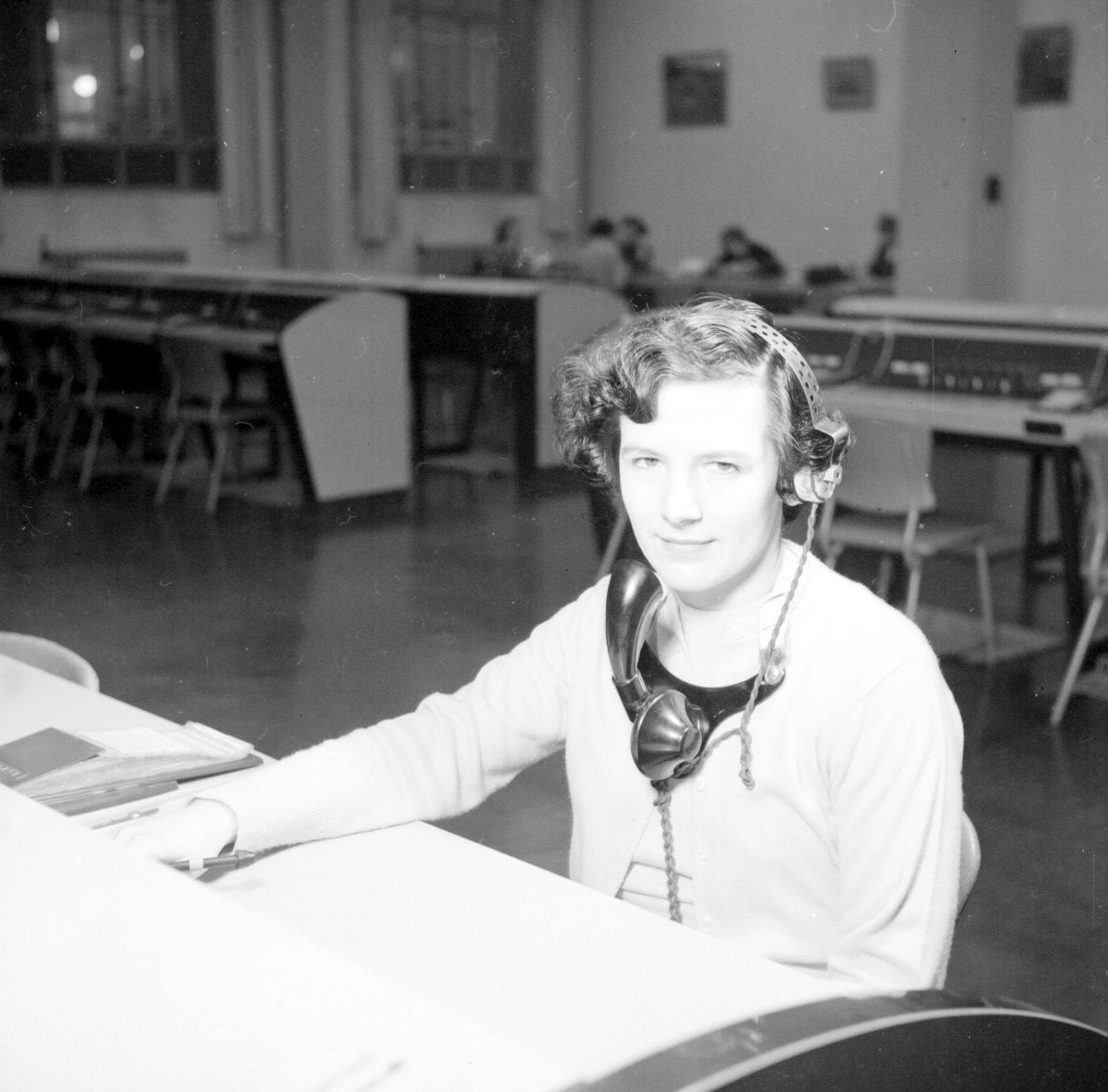
Over the course of this long standing relationship the Unit carried out many specific research projects and gave advice on problems such as:
-
The perception of speech in a background of noise
-
Dial and Keypad design for entering phone numbers
-
Short term memory for number and letter sequences
-
Directory Enquiry operation and dialogues
-
Instructional material for the use of coin operated telephones
-
Use of phones by the disabled
-
and many more
It is of particular interest to note that the research on memory for letters and digits provided key evidence that human memory was composed of a short-term system, which coded the sounds of speech, and a longer-term system which coded meaning. It was a classic example of how looking at new real world problems contributed to scientific advance.
Research on postal systems
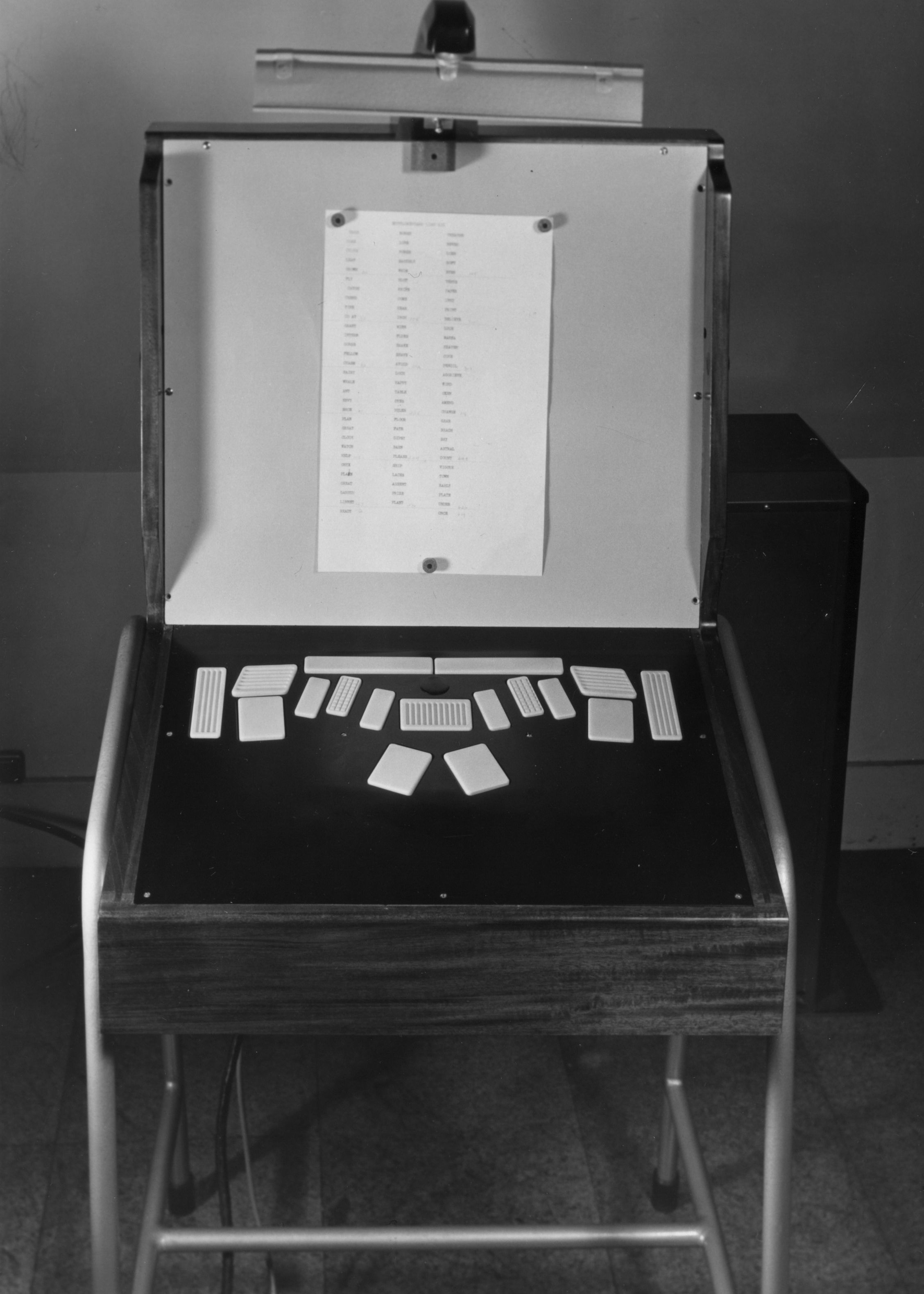
Unit research for the Post Office included advising on
- The discriminability of alternative stamp designs
- The design of the current UK system of postcodes (CB2 7EF, IP22 4LX, BS8 2PQ….
- Keyboard skills, typing and equipment design
The image shown below is the earliest form of system for postcode entry and sorting. While the image on the left is of an experimental “chord keyboard.” The following film clip from 1960 illustrates APU experiments on letter sorting, codes, and keyboards undertaken for the Post Office.
Letter sorting film clip
(Open the film by cliking on the line above – You can control starting and stopping from the panel at the bottom of the film window after it opens up)

The Introduction of Decimal Coins
Investigating new coin sets
Great Britain completed the process of converting to a decimal system of coinage on the 15th February 1971.
When it did so the coins shown on the left hand side of the figure below were replaced with those on the right hand side.
However the new coins were gradually introduced before the 1971 date. When the the seven-sided 50p piece was introduced in 1969, many found it hard to tell it apart from the new 10p and old “half-a-crown.” Pat Wright and her colleagues at the Unit carried out a number of experiments to determine how easy it was to distinguish between alternative shapes for these coins.
You can see a news item about this problem on the BBC website
Research on Driver Behaviour
Background
How human error contributes to accidents and compromised performance has been a vital and lasting theme of much Unit research since it opened in 1944. As car use rapidly spread, studies of driver behaviour became a long-standing topic for Unit research lasting up until 1993. Much of this research involved collaboration with the Transport and Road Research Laboratory.
Themes

Over the years our studies of driver behaviour included:
- Measuring many aspects of car control
- Doing a secondary task while driving
- The effects of alcohol (the upper picture to the left shows a member of Unit research staff, purely in the public interest, drinking a measured quantity of alcohol before driving)
- Steering through narrow spaces and following other cars
- Estimating time to collision
- Accidents with pedestrians
- Bus driver selection
Research on driver behaviour featured in many of the films made about Unit Research. You can get a sense of our research at different times by looking at flip clips from three periods – just click on the decade then start the film playing from the control panel at the base of the film.
Early 1950’s This features basic monitoring equipment and measurement techniques in use at the time
1960 This features dual task performance as a function of driving in different traffic conditions (think mobile phones and sat navs now)
1971 This features pedestrian accidents in the first part of a longer film about unit research
Research on assessing human performance when diving and when at high altitudes
Diving
In its early years the unit conducted some research for the navy on performance in an underwater environment, and Gregory’s work on submarine escape is one notable example.
The development of our north sea oil reserves provided new impetus for research on performance when diving and, when at considerable depths, on the effects of breathing mixtures of gases rather than compressed air. Since Alan Baddeley (APU director 1974-1996) was himself a keen diver, this topic allowed him and some colleagues to combine business with some pleasure!
Testing performance at depth and on the surface
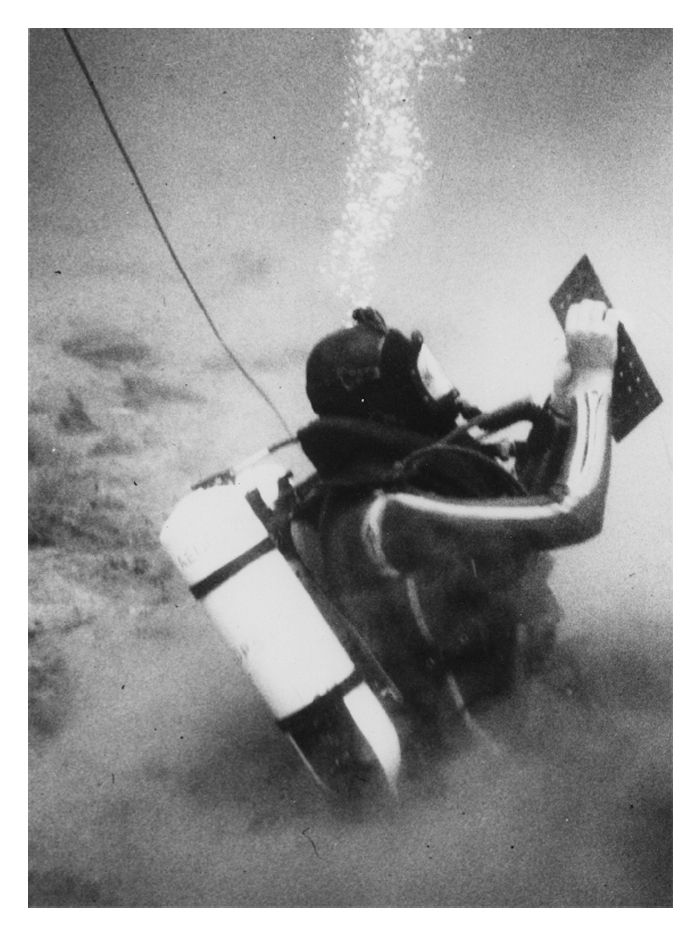
The picture shows Alan Baddeley carrying out “the screwplate test” at a depth of 200ft off Malta in 1965.
Work by Baddeley and Idzikowski published in 1985 used this test. Here is their own summary of that study:
The open-sea performance of divers at depth may be substantially lower than would be predicted from dry pressure-chamber simulation studies. This has been attributed to the effects of anxiety. This hypothesis was explored using land-based study in which the manual dexterity of 32 novice divers was tested using a screwplate test on two occasions, immediately before a potentially stressful open-sea dive, and at a time when diving was not imminent. Both pulse rate and subjective ratings suggested that the pre-dive condition was associated with anxiety. Speed of completing the screwplate test deteriorated by approximately 6%, a significant but not large impairment. Implications for the anxiety hypothesis of open-sea decrement are discussed.
Two years later Logie, Baddeley and Williams reported on the effect on diver performance of breathing different mixtures of gases:
Human mental performance was studied in eleven simulated dives. Results showed that in oxyhelium mental abilities were impaired by about 15 % at 300 metres. Impairments were greater with greater depths, and performance at 540 metre was impaired by as much as 80% in some cases. These results could not be explained by sleep loss or mood changes, the time of day or by long periods spent in a cramped environment. One dive to 660 metres investigated claims that TRIMIX (helium, oxygen and nitrogen) may prove beneficial. However in this dive performance was worse than that found in oxyhelium at equivalent depths. One other ‘control’ dive involved a maximum depth of 61 metres in oxynitrogen, where the partial pressures of these gases were identical to those in the deep TRIMIX dive. Results suggested that the results with TRIMIX were not due to the partial pressure of nitrogen, but to an interaction between the gas mixture and overall pressure. Performance impairments at 55-60 metres in oxynitrogen are of the same order as those found at 300 metres in oxyhelium. These results have important implications for maximising the safety of human divers in an extremely hazardous environment.
(we have specified the depth in metres, the correct index is actually “MSW” – the technical abbreviation for metres of sea water)
Testing Human Performance at High Altitudes
The mechanical card sorting apparatus shown in the photo below was developed at the APU. It was taken up Mount Everest on the Silver Hut Expedition of 1960-61 to test the effects of altitude and fatigue on performance. The card sorting apparatus is now kept in our library at here at Chaucer Road.
A paper by Gill, Poulton, Carpenter, Woodhead and Gregory appeared in the journal Nature in 1962 with the title “Falling efficiency at sorting cards during acclimatisation at 19000 feet.”
Government forms, leaflets & hospital signage
Disruption of sleep and shiftwork
Video monitoring
Background
Today in almost any public space we are subject to monitoring by closed circuit television. In the 1950’s the Unit started to research the potential of video cameras for use both in the Laboratory – for monitoring eye movements – and in the real world of security applications. Some of the earliest research on the monitoring of multiple displays was carried out at this Unit.

Handwriting research
Juror Comprehension in Complex Fraud Trials
Background
Our legal system relies on eye-witness testimony and juries of ordinary people. The Unit undertook studies on both topics in the 1980’s.
In this period, the Government set up a committee chaired by Lord Roskill to consider how complex fraud trials should be handled. The Unit received a contract from the Roskill Committee to study how jurors come to comprehend and judge evidence in the process of making verdict decisions.
The Unit also had an interest in examining techniques used for the presentation of evidence in court. Our aim was to identify techniques which can improve jurors’ comprehension and retention of evidence.
Experimental Studies
One study examined how lay-jurors can be helped to understand complex evidence. The study simulated some aspects of courtroom procedures and focussed on presentation techniques that could be used in a judge’s final summing-up of evidence. It was found that reinstating the order in which evidence had been originally presented facilitated not only comprehension but also memory for highly complex evidence.
Another study has looked at the relationship between memory for evidence and verdict decision using simulated jury conditions. Although the dominant explanation of verdict decisions is that they are determined by how well a juror understands and remembers case evidence (that is, a juror who remembers more about the prosecution case will be likely to reach a guilty verdict), the data showed no biases in memory which could usefully discriminate between jurors returning different verdicts. In other words, what a juror remembered could not be used to predict that juror’s verdict.
Other work on eye-witness testimony can be found by using these keywords in our bibliographic database.
You can also refer to that database for the Unit report to the Roskill Committee
Bekerian, Conway, and Dennett (1986) Improving juror understanding and memory for evidence by pre and post evidence summaries. In Improving the Presentation of Information to Juries in Fraud Trials, Report to Lord Roskill Committee on Fraud Trials, London: H.M.S.O., pp.53-63.
Sporting skills (catching and batting)
Research on Human-Computer Interaction
Background
Although simple computers were invented during wartime, it was only in the late 1960’s that mini-computers became affordable for day-to-day use in research laboratories and only in the 1980’s that personal computer use become widespread in the workplace and home.
The Unit became interested in “Human-Computer Interaction” in 1970 and subsequently went on to build a very substantial programme of research on the use of command languages, visual and multimodal interfaces. This streand of research came to an end in 1995.
Themes
This short film clip from 1971 illustrates some early Unit research on human computer interaction.
Auditory Warnings
In fixed wing aircraft and helicopters
Civilian and military aircraft have a wide range of mechanical, visual and auditory means of warning their pilots that something is wrong. As the complexity of aircraft systems increased, it became very clear to both pilots and the Civil Aviation Authority that the auditory warnings often heard in a cockpit were “non-optimal.” The warnings were loud and often distracted pilots from dealing with the really important problems as the following quote indicates:
‘I was flying in a Jetstream at night when my peaceful reverie was shattered by the stall audio warning, the stick shaker, and several warning lights. The effect was exactly what was NOT
intended; I was frightened numb for several seconds and drawn off instruments trying to work out how to cancel the audio/visual assault rather than taking what should be instinctive actions. The combined assault is so loud and bright that it is impossible to talk to the other crew member, and action is invariably taken to cancel the cacophony before getting on with the actual problem.’
Unit Research, supervised by Roy Patterson, analysed many different aspects of the cockpit environment, background levels of noise and flying tasks. As a result of this research, a new system of warnings was developed. Key design features involved developing sounds that had a gentle onset and offset to avoid startle (e.g. top line in the figure above), sound patterns with a distinctive identities and rhythms (e.g. second line of figure – burst) and where the repeats of a warning varying in intensity and urgency (third line of figure). This form of warning notifies the crew of the distinct identity of a problem, then recedes, and comes back later with a more urgent character if left unattended.
All RAF and civilian helicopters flying over water for more than 3 minutes from UK airspace must now carry a low altitude (and optionally other) warnings with these characteristics.
Warnings in other forms of transport &workplaces
The basic principles developed for auditory warnings at APU were subsequently extended, and demonstration systems were produced for the flight decks of civil airliners, intensive-care wards in hospitals, trackside maintenance staff working on railway lines, and firemen on duty in London Fire stations. The latter two systems were implemented and are currently in operation.
The warning systems designed for hospitals and civil aircraft require the establishment of international standards (by ISO and IATA, respectively) and efforts to enact these standards met with an endless succession of hurdles which has to date prevented widespread adoption of auditory warning systems. Implementation requires political will as well as good research!
Computer generated speech
‘P-Centres’
Today we frequently hear speech that is generated by a computer – dialogues with directory enquiries are a good example where the computer generates the phone number you ask for. In the early 1970’s, a group of researchers at the Unit discovered that sequences of numbers generated by a computer sounded irregular if the output was aligned to speech onset. They developed a method for finding the “perceptual centres” of words. If these P centres occur at regular intervals the numbers sound more natural. When you listen to these types of sequences today, they sound regular because they are P centre corrected.
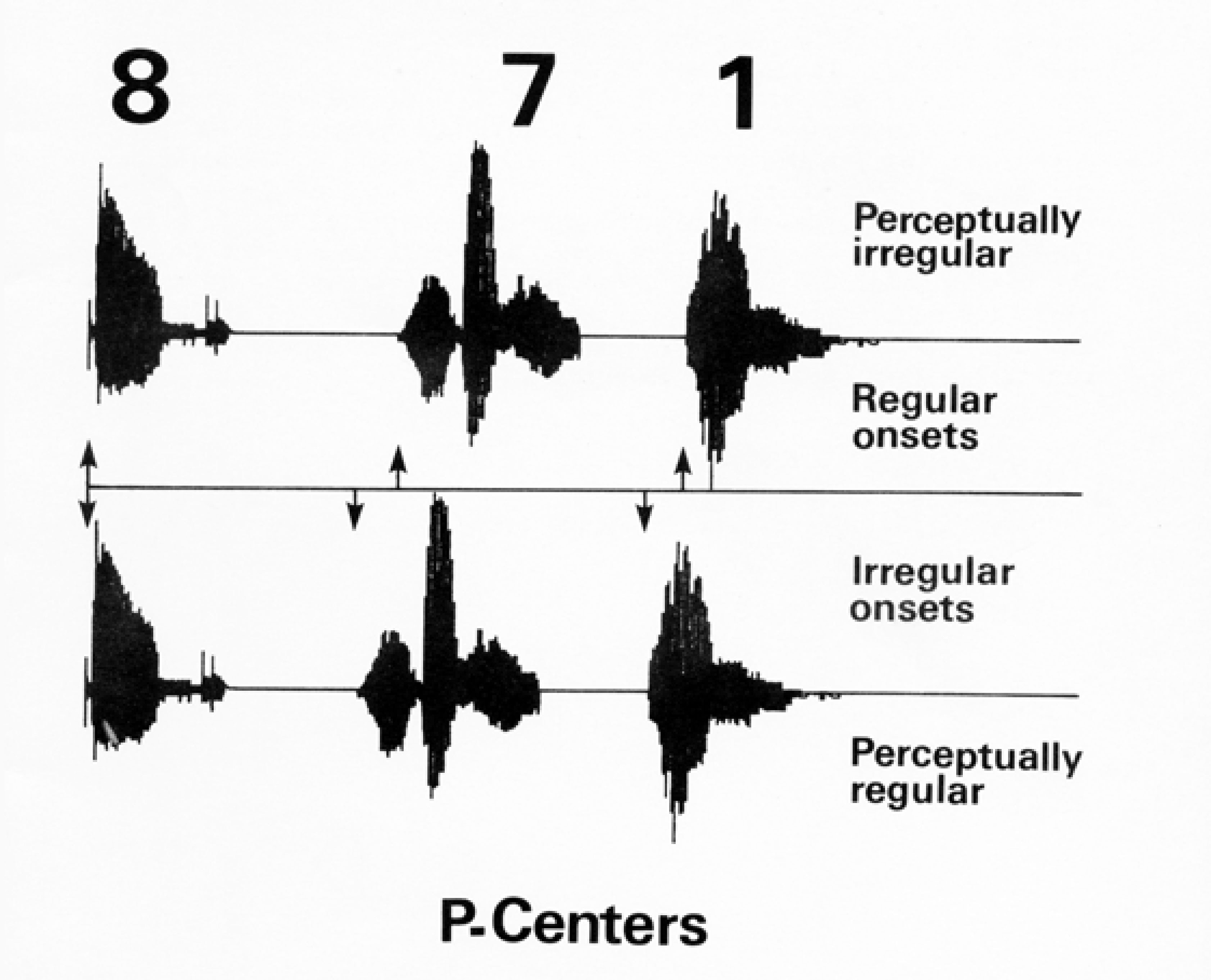
Helping Children with Reading and Language Problems
The Intuitive Colorimeter
Arnold Wilkins discovered that some children with reading difficulties could be helped by placing a transparent coloured overlay over the material they were trying to read. While working at the Unit he developed the device shown to the left, called the Intuitive Colorimeter, to measure the best colour of overlay to use for each individual child.
It is currently in quite widespread use by opticians across the country.
The picture below illustrates the use of the overlays. Tinted lenses are also now prescribed and you can find out a lot more about the uses of this approach by visiting this page of Arnold’s current website at the University of Essex.
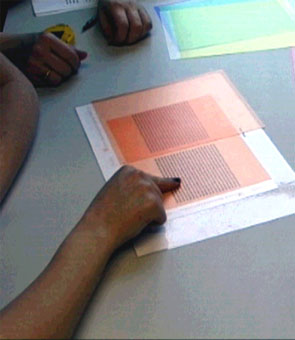
Face Recognition, identity parades and disguise
While the impact of some research is swift, it is important to remember that there is often a large time lag between basic research being carried and its having an effect on real people’s lives.
Medicine, Rehabilitation and Mental Health
The return of wounded soldiers in the Second World War presented significant problems for their rehabilitation following brain injury, deafness, other physical disabilities and war-related mental health problems. From the wartime years onward, and consistent with wider Medical Research Council and NHS objectives, the unit has consistently maintained a strong profile of projects in these areas. Several of these projects have led to significant developments in assessment and diagnosis, in treatment protocols and in the development of technological aids. Our coverage has included
-
Disorders of speech and language
-
Disorders of memory and attention
-
Deafness and Cochlear Implants
-
Disorders of motor control
-
Rehabilitation following Traumatic Brain Injury
-
Problems with conscious awareness
From the Early 1980’s the Unit also developed a strong programme of research in the domain of mental health. This work has led to a number of advances in diagnosis, treatment and care. Coverage has included
Background
Although neuropsychology and mental health have always been a part of the portfolio of research interests at the Unit, a major new research group was set up in 1984 by Alan Baddeley (Director 1974-1996) to explore links between basic research in cognition and emotion and mental health. Key figures from clinical research were recruited over the course of the next decade (Fraser Watts, John Teasdale, Mark Williams and Andrew Mathews) to create a new research group with critical mass. The emphasis for the group was very much on developing basic research that could go on to influence the developments of new therapies.
To view our current work in this area please refer to the Research pages on from the menu of the main website.
Unit research on depression focused on how it affects people’s ability to concentrate, solve problems and remember things. By understanding how basic mental mechanisms function in varying mood states, we hoped to guide the development of new interventions.
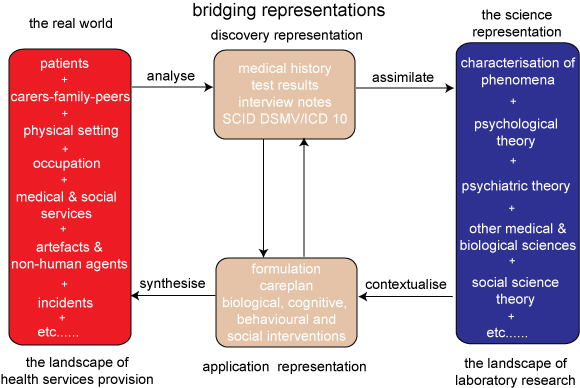
The left hand panel of this figure shows what is involved in the provision of health services, while the right hand panel shows relevant topics that are addressed in basic, laboratory research. The aim is to develop systematic bridges between the two – something now called translational research. There is often a long lag between the development of new theoretical ideas based on empirical research and the widespread adoption of therapeutic techniques developed out of those ideas.



—-2007———2002——–1993—–
The three books shown above illustrate the timescale. Initially some key research ideas were developed in the late 1980’s, published in a journal as a body of basic theory in 1991 with a longer theoretical analysis of depression treatment appearing in a book in 1993. Some of the ideas were used as a rationale for a new way of treating people with recurrent depression when their symptoms were in remission (see Teasdale, 1999; CBU Bibliography). The technique is called “Mindfulness-Based Cognitive Therapy” (MBCT) which was evaluated in clinical trials and shown to reduce the rate of relapse into depression by half. The protocol for the therapy was then documented in a book aimed at clinical practitioners (2002) with a further book, aimed at self help using this technique, appearing five years later (2007). The whole process lasted very nearly 20 years and MBCT is now endorsed by the National Institute of Clinical Excellence (NICE) as an effective treatment for the prevention of relapse.
-
Anxiety conditions and Phobias
-
Post-traumatic Stress Disorder
This research has typically involved close collaboration with clinical services in or near Cambridge including Addenbrookes Hospital, the Oliver Zangwill Centre in Ely, and local mental health services.

 MRC Cognition and Brain Sciences Unit
MRC Cognition and Brain Sciences Unit

